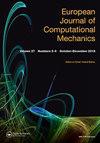The Implementation of Numerical Codes for the Analysis of Solar Flux Inputs and the Optimization of Thermal Comfort for a Monobloc Habitat
IF 0.6
Q3 MECHANICS
引用次数: 0
Abstract
The purpose of this work is to design computer codes to estimate the different thermal exchanges of the facades of a habitable envelope with its environment in order to optimize thermal comfort. This optimization is based on the use of real climate data from the region under consideration. To achieve this goal, we have developed five fundamental codes in FORTRAN language. The first code consists in Modelling the flow of the heat transfer fluid in the heating slab pipe. The second is designed to model the heat transfer by conduction within the concrete slab. The third is developed for the Modelling of thermal exchanges in a habitable envelope assimilated to a parallelepipedal cavity based on the nodal method. The fourth code is reserved for the Modelling of solar radiation by evaluating the wage flux density on different positions of the walls. The fifth and last code is dedicated to the evaluation of the perfect thermal coupling between the concrete slab and the heat transfer fluid pipes. The validation of the models implemented in the calculation codes was made on the basis of data measured recently for a clear sky of solar radiation at the radiometric station of the renewable energies research unit in the Saharan environment URER’MS of Adrar. The results obtained showed a very good agreement between the calculated values using the computational codes developed and those measured by the radiometric station of the URER’MS during the typical day.用于分析单个生境的太阳通量输入和热舒适性优化的数值代码的实现
这项工作的目的是设计计算机代码,以估计可居住外壳外立面与其环境的不同热交换,从而优化热舒适性。这一优化是基于使用所考虑区域的真实气候数据。为了实现这一目标,我们用FORTRAN语言开发了五个基本代码。第一个代码包括对传热流体在加热板管中的流动进行建模。第二种是设计用于模拟混凝土板内的传导传热。第三种是基于节点法建立的平行六面体空腔适居外壳中的热交换模型。第四个代码用于通过评估墙壁不同位置的工资通量密度来模拟太阳辐射。第五个也是最后一个代码专门用于评估混凝土板和传热流体管道之间的完美热耦合。计算代码中实施的模型的验证是基于最近在撒哈拉环境中的可再生能源研究单位的辐射站测量到的晴朗天空的太阳辐射数据。所获得的结果表明,使用所开发的计算代码计算的值与URER’MS辐射站在典型白天测量的值之间非常一致。
本文章由计算机程序翻译,如有差异,请以英文原文为准。
求助全文
约1分钟内获得全文
求助全文

 求助内容:
求助内容: 应助结果提醒方式:
应助结果提醒方式:


